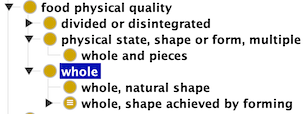Consider a scenario in which we are informed that a biosample contains liver. Does that mean one liver, whole intact livers, or liver parts, or a mixture of liver parts and wholes?
Even if told exactly one liver is given, from the usual food science context we may be loose about exactly what its extremities are – it has a fiat boundary across the various ways it is attached to the rest of an animal. The act of removal may well leave some liver tissue in place; we’d still call the remainder liver.
This gets us into a discussion about how OWL ontologies handle (mereological) parts and wholes. A first step to keep things simple is to ensure all terms are defined as singular entities even if they are mass nouns or have many members. We define “a carrot is a root vegetable” rather than “carrots are root vegetables”; We say “a population is a collection of individuals” rather than “populations are collections of individuals”. In the hypothetical example below, the ‘has part’ relation, which allows the part to be the whole entity or a proper part, even a tiny bit, is used to define liver flexibly. The extra “… only liver” means no other anatomical or other parts are allowed.
liver (food product): 'has part' some liver and ‘has part’ only liver.
pig liver: liver (food product) and 'derives from’ some pig (organism).

Then we can use the FoodOn term “whole” to express that an existing (non-mass noun) singular entity is whole or intact (to the extent that fiat boundaries allow). As shown in Figure 1, some food products can even have a finer distinction made about their “wholeness” resulting from food processing.
whole liver (food product): 'liver (food product)' and 'has quality' whole.
An organ like liver may have its component parts (right lobe, left lobe, haptic nerve etc.) detailed in an anatomical ontology but we haven’t imported such axioms into FoodOn, and so having a “whole” quality does not currently entail anything further.
The anatomy ontologies that FoodOn uses, Uberon for mammals and PO for plants, base their part terms under “anatomical structure” and “plant structure”, respectively, and equate these terms with CARO’s “connected anatomical structure” (CARO:0000003). However, for some reason CARO’s term is under the “independent continuant > biological entity” path, i.e. a sibling to “material entity” rather than under it. The “material entity” definition plainly encourages organisms to be placed under it, and so we treat Uberon and PO anatomy part terms as material entities (which are allowed immaterial continuant spaces like lung cavities).